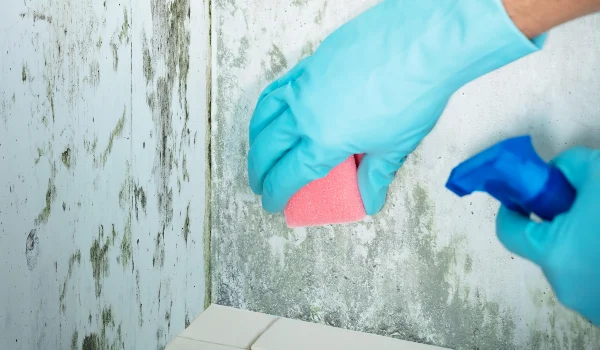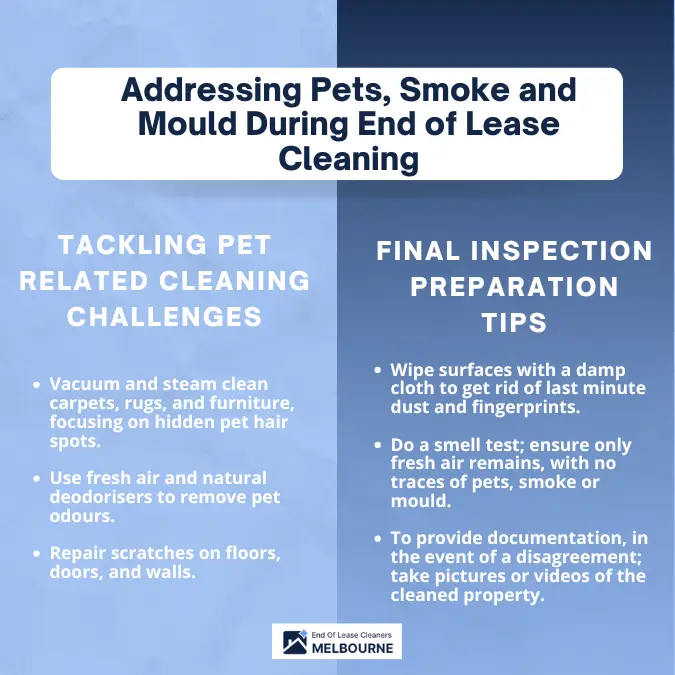Moving out of a rental property entails leaving the place in the same condition that you found it in. While standard cleaning duties such as dusting and mopping are expected, certain challenges can be particularly difficult to overcome. If you have had pets, been exposed to smoke or discovered mould growth, you will need to pay special attention to these issues before your final inspection. Ignoring them may result in losing a portion of your bond money.
For tenants in big cities, especially when it comes to expert end of lease cleaning Melbourne; the stakes are high. Property managers are strict about cleanliness, and landlords expect the property to be restored to its original state. This article will assist you in addressing pets, smoke and mould during end of lease cleaning. Knowing how to manage these concerns properly, will give you the confidence to pass the inspection and get your bond return.
1. Tackling Pet Related Cleaning Challenges
Pets usually leave behind fur, dander and odours that are immediately detectable during inspections. The first step in dealing with this is to thoroughly vacuum and steam clean carpets, rugs and furniture. Even when surfaces look clean, deep fibres may still hold smells and traces of pet hair. Pay extra attention to corners, skirting boards, and behind furniture, as these spots often trap fur and dust.
Odour removal is equally crucial. Open windows to allow fresh air circulation and use natural deodorising agents like baking soda or vinegar sprays to neutralise smells. If your pet has caused scratches on wooden floors, doors, or walls, take time to polish or repair them. These minor fixes reflect care and responsibility, which may prevent landlords from charging you for damages.
2. Addressing Smoke Residue and Odours in the House
Smoke is one of the most difficult concerns residents confront since it adheres to walls, ceilings and soft furnishings. Simply airing out the property is not enough. Start by scrubbing walls and ceilings with a vinegar water mix or specialist cleaning solutions to remove yellowish stains and embedded particles. Wash curtains, blinds and cushion covers since fabrics absorb odours the most and can quickly become noticeable during inspections.
For carpets and upholstery, a professional steam clean may be required to fully eliminate odours and residue. This is especially crucial for allergy and asthma patients, as residual smoke particles can aggravate respiratory issues and create an unhealthy atmosphere. Activated charcoal bags and air purifiers, can also help to eliminate lingering odours. If smoking is common indoors, landlords often require professional cleaning receipts as proof of comprehensive cleanup. To prevent bond deductions, you must address this issue seriously.
3. Dealing with Mould Effectively

Mould thrives in damp, poorly ventilated environments like bathrooms, kitchens, and laundry rooms. If left addressed, it not only harms surfaces but also offers a health risk. Begin by cleaning the tiles, grout and affected areas with mould killing chemicals or a vinegar solution. To protect yourself from spores, always wear gloves and ensure you have sufficient ventilation while cleaning.
Do not overlook hidden areas such as under sinks, behind furniture, or around windows. Landlords check these spots carefully, so be thorough. If the mould is extensive or difficult to remove, hiring professionals is the best option. Many end of lease cleaning Melbourne services involve mould treatment, which ensures that the home is safe and clean.
4. Why Professional Cleaning Can Be Worth It
While DIY approaches can save money, professional cleaning is more efficient and produces assured results. Experienced cleaners utilise industrial grade equipment and solutions that are significantly more successful than traditional residential methods for cleaning pet odours, smoke and mould. This not only saves time but also assures that, the property fulfils the landlord's strict standards.
Another significant benefit is peace of mind. Many landlords request invoices for professional carpet cleaning or pest control if pets are present. Hiring a reliable end of lease cleaning service guarantees that all standards are satisfied lowering the likelihood of a conflict. Hiring professionals is generally considerably cheaper than losing bond money.
5. Final Inspection Preparation Tips
Once you have tackled all major cleaning challenges, preparing for the end of lease cleaning Melbourne inspection is the last step. Use the entry condition report as your guide and double check that every area matches the original state of the property.
Here are some practical tips to use as a checklist:- Walk through each room with the entry condition report; compare the current state with the original documentation.
- Landlords usually conduct thorough inspections of hidden spaces including corners, skirting boards, and cabinets.
- Wipe surfaces with a damp cloth to get rid of last minute dust and fingerprints.
- Do a smell test; ensure only fresh air remains, with no traces of pets, smoke or mould.
- To provide documentation, in the event of a disagreement; take pictures or videos of the cleaned property.
Attention to detail not only helps to avoid arguments but it also gives the landlord a good picture of how you kept the property.
Infographic: Addressing Pets, Smoke and Mould During End of Lease Cleaning

Wrapping Up
End of lease cleaning can be stressful, especially when pets, smoke, and mould are involved. However, with careful preparation, thorough cleaning, and, in some cases, expert assistance, you can effectively address these difficulties. Whether you clean it yourself or employ professionals, keeping your rental property pristine can create a lasting impression and ensure your bond refund.